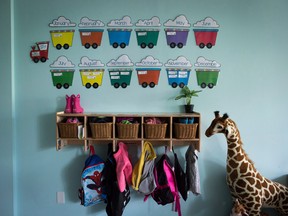The intermittent care many Alberta resource-sector families need is not eligible for federal funding. Alberta should take the cash instead
Article content
In recent months, Alberta has rejected federal clean electricity regulations and opted out of federal pharmacare and dental care. In each case, Alberta has wanted to free itself from made-in-Ottawa programs and rules so it could develop its own local solutions. So why hasn’t it added child care to its opt-out list? In fact, to date it has generally embraced the federal government’s Canada-Wide Early Learning and Child Care (CWELCC) program, also known as “$10-a-day care.”
Advertisement 2
Article content
But from the beginning this agreement has never worked for Alberta. As Cardus has reported, the program’s roll-out in the province was slow and problem-ridden. Many child care operators have had terrible experiences since signing onto it, including delayed subsidy payments and significant administrative burdens, such as extensive new audit and reporting requirements. With the current contract up for renewal in March 2025, operators are weighing their options and many are considering pulling out of CWELCC.
Alberta’s economic needs are unique, with more than double the national average of its work force employed in the resource sector. Only Newfoundland & Labrador has a higher percentage of resource-sector workers, and it is experiencing similar child care challenges. But it’s not just the scale of the resource sector that counts. It’s also the make-up. With Alberta’s resource sector centred in oil & gas, family living situations (and therefore care needs) are different, too. Working in the oilfields often means frequent travel, shift work and rotations, often in two-week spurts.
Article content
Advertisement 3
Article content
Under CWELCC, only centre-based child care is covered. Most centres follow traditional working hours and need parents to commit to and pay for full-time care to maintain their children’s spots. Their business needs are perfectly understandable but how can such arrangements possibly work for a resource sector family when their care needs for the first two weeks of the month are completely different than for the last two?
Alberta’s child care system has long reflected this reality. Before Ottawa’s program began, only 27 per cent of Alberta children six and under were in centre-based care or pre-school — the only types of care eligible for federal funding. By 2023, that percentage had barely budged to 33 per cent.
That means two-thirds of Alberta families are not using the $10-per-day child care program.
Why does Alberta stick with a program that only benefits a third of its families? When it comes to lowering child care costs, well, sorry, you’re out of luck if you are: parents who work jobs involving non-traditional hours or plenty of overtime; a multi-generational home where a grandparent cares for the kids while mum and dad work; or a family with a great child care set-up involving a highly trusted, yet unlicensed home provider in your neighbourhood.
Advertisement 4
Article content
Constitutionally, child care is a provincial responsibility. Yet the current set-up sees Ottawa dictating what types of care Alberta can fund and therefore what portion of care programs are eligible for money.
This year began with closures of child care centres across Alberta. Operators shut down their centres to highlight the unsustainability of the $10-per-day program. With the strict operational parameters CWELCC imposes on operators, many entrepreneurs have seen their businesses lose value, some to the verge of insolvency. Between the agreement’s cost-control framework, including restrictions on adjusting fees to reflect inflation, and the inability to expand a centre by gaining licensed spaces, providers have been pushed to their breaking point and have called on the province to opt out of CWELCC entirely.
It should come as no surprise that Ottawa has essentially told the provinces to take a hike. No more money. No re-negotiation. No flexibility. As far as the federal families minister is concerned, provinces knew what they were signing up for: they just need to deal with it and stop complaining.
Advertisement 5
Article content
In late February, Alberta announced changes to its administration of the CWELCC program, including updating the timeline for payments to child care operators and placing the province’s economy minister in charge of delivering the program in a more business-friendly way. But technical updates cannot solve an inherently flawed program. There has been no update to support the many parents whose children are either stuck on a waitlist or who may not get any subsidy at all because, so far as the federal government is concerned, they have chosen the “wrong” kind of care.
Premier Danielle Smith always says her government will not put up with federal programs that take advantage of the province. Unfortunately, that’s exactly what’s happening with child care. Federal funding is not a gift; it is Albertans’ tax dollars — doled back to the province with too-many-to-count strings attached.
Recommended from Editorial
This agreement has disappointed parents, small-business owners and child care advocates alike. It’s clear it doesn’t and can’t work: the challenges Alberta has faced are by design, not by accident. For the good of Alberta’s families, the provincial government should opt out of CWELCC and instead argue — as Quebec often does — for a lump-sum payment so it can design its own program.
Financial Post
Catharine Kavanagh is Alberta liaison officer for the nonpartisan think-tank Cardus.
Bookmark our website and support our journalism: Don’t miss the business news you need to know — add financialpost.com to your bookmarks and sign up for our newsletters here.
Article content



